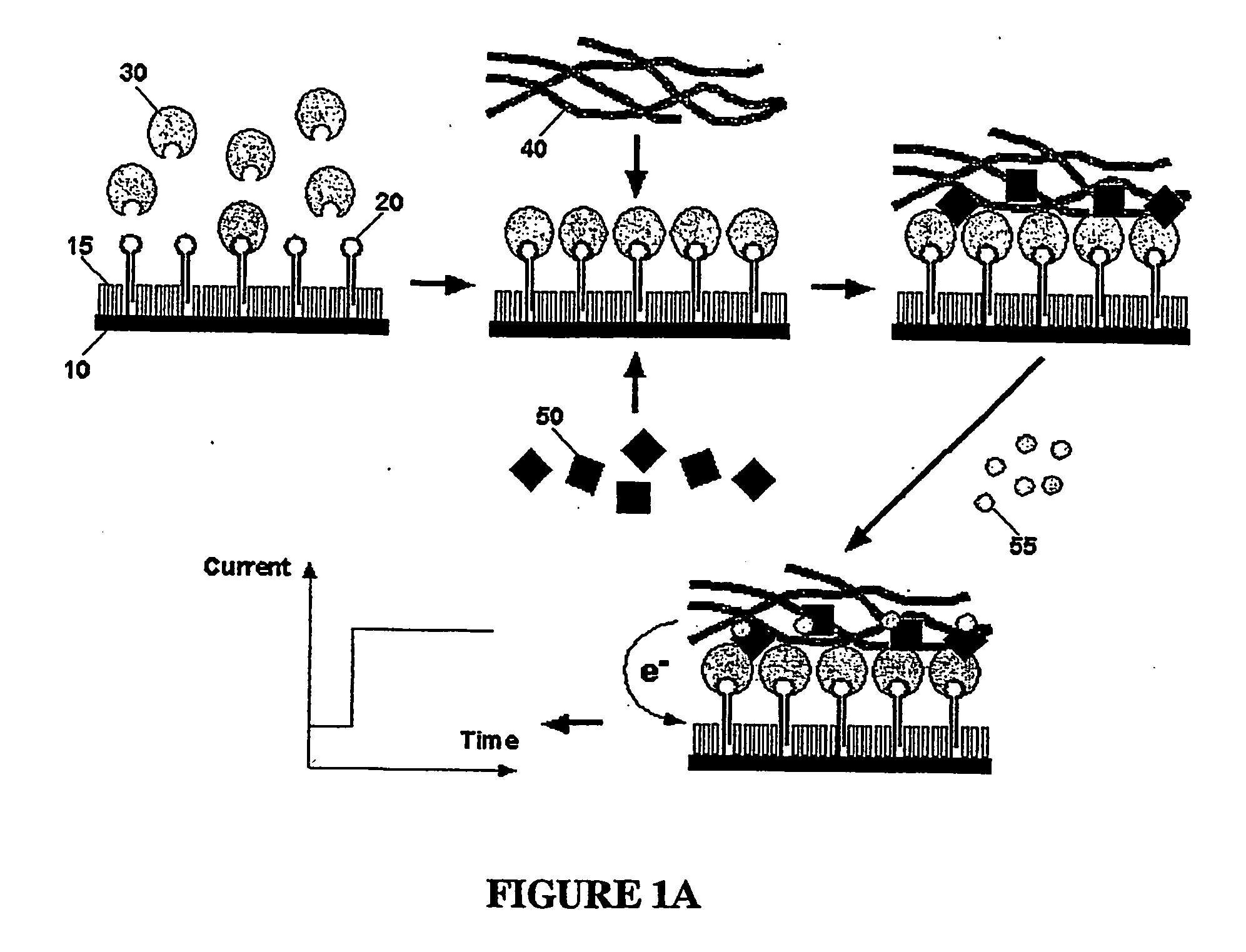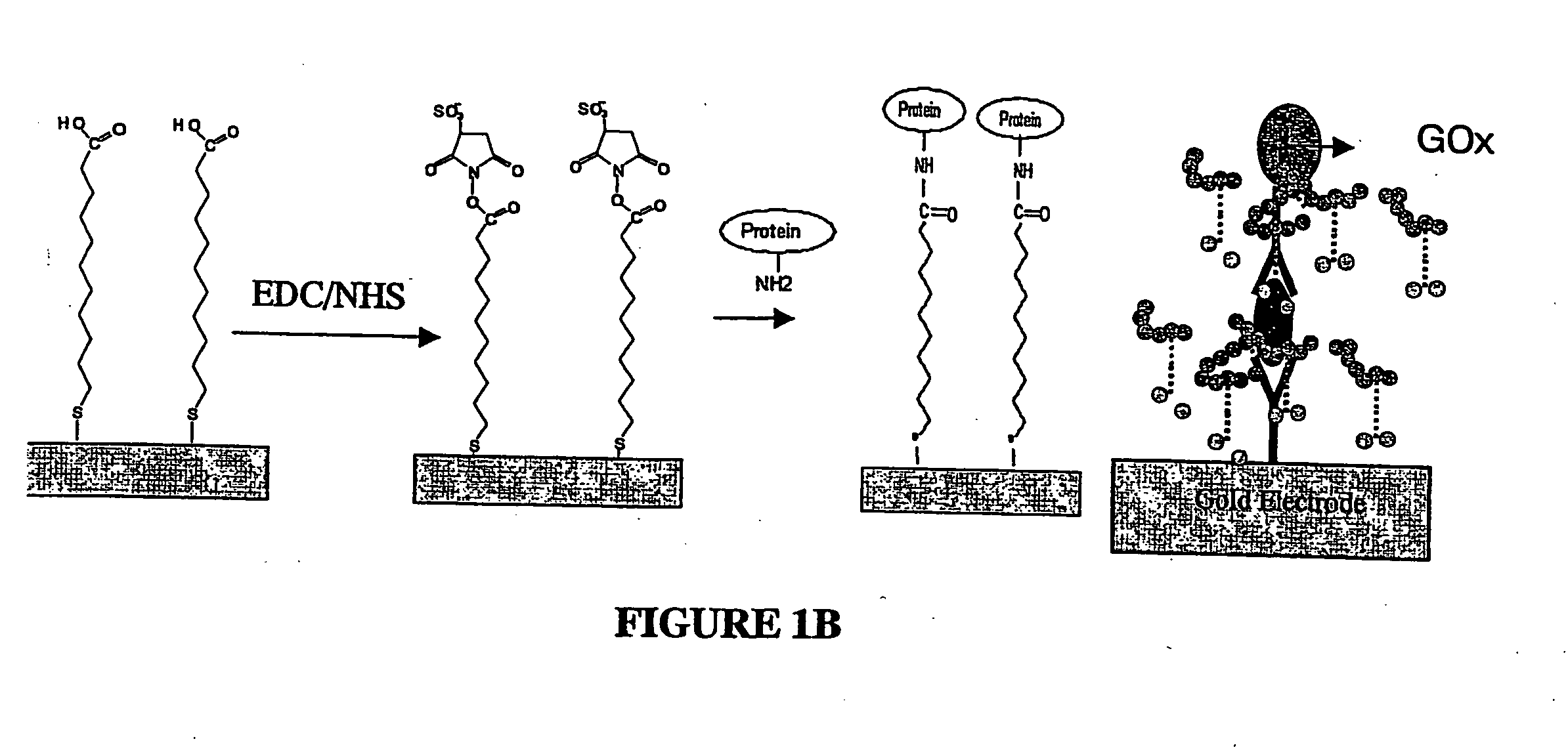Method for detecting analytes by means of an analyte/polymeric activator bilayer arrangement
an analyte and polymer activator technology, applied in the direction of liquid/fluent solid measurement, material electrochemical variables, instruments, etc., can solve the problems of expensive reagents and technical equipment, inability to apply autoradiography in many fields, and tedious labeling procedures
- Summary
- Abstract
- Description
- Claims
- Application Information
AI Technical Summary
Benefits of technology
Problems solved by technology
Method used
Image
Examples
example 1
Detection of Nucleic Acids
[0111] In general, the detection of nucleic acids according to the invention is performed as illustrated in FIG. 1. First, a mixture of thiolated oligonucleotides (also carrying a biotin modification as label) serving as capture molecules (20) and thiol molecules serving as blocking agent (15) for reducing the background is immobilized on a gold electrode surface (10). Then, the electrode is exposed to a solution supposed to contain the target analyte (30). Following hybridization to its complementary biotinylated target DNA (i.e. the capture molecule) an enzyme-conjugate (50) is attached via avidin-biotin interaction. Finally, a redox polymer (40) is brought to the electrode surface through layer-by-layer electrostatic self-assembly. The redox polymer layer electrochemically activates the enzyme labels bound to the target DNA. In the presence of substrate molecules (55), the current generated from the catalytic oxidation of the substrate are detected ampe...
example 1.1
mRNA Extraction from Rat Tissues and Synthesis of Biotinylated cDNA
[0112] The extraction of rat liver mRNA was performed using the Dynabeads® mRNA DIRECT™ Kit (Dynal ASA, Oslo, Norway) according to the manufacturers instructions. For reverse transcription (RT), 10 ng of this mRNA were used in a total volume of 20 μl containing 1×eAMV buffer from Sigma-Aldrich (50 mM Tris-HCl, pH 8.3, 40 mM KCl, 8.0 mM MgCl2, 1 mM DTT), 500 μM of each dNTP, 1.0 μM anti-sense primer, 20 U RNase inhibitor, and 20 U enhanced avian myeloblastosis virus reverse transcriptase (eAMV). The samples were incubated for 50 min at 56° C. in a DNA thermal cycler (Gene Amp PCR System 9700, Applied Biosystems, Foster City, Calif., USA.) and the cDNA obtained was directly used as template for PCR amplification.
[0113] PCR was performed with 2.0 μl of the RT-reaction mixture in a total volume of 50 μl containing 1× AccuTaq buffer from Sigma-Aldrich (5 mM Tris-HCl, 15 mM ammonium sulfate, pH 9.3, 2.5 mM MgCl2, 0.1% Tw...
example 1.2
Capture Probe Immobilization and Evaluation of Monolayer Quality
[0117] Prior to the detection of a DNA analyte, a mixture of thiolated oligonucleotides, served as capture probes, and thiol molecules were immobilized onto the gold electrode surface through self-assembly. To minimize non-hybridization related uptake of the target DNA, anionic thiol molecules were used to form the blocking component of the mixed monolayer. The following capture probes were used: for the detection of GAPH, 5′-T12TTACTCCTTGGA GGCCATGTAGG-3′ (SEQ ID NO: 5); and 5′-T12ATG GTGMGGTCGGTGTCA ACGG-3′ (SEQ ID NO: 6); for the detection of TP53, 5′-T12ATGGAGGATTCAC AGTCGGA-3′ (SEQ ID NO: 7) and 5′-T12TCAGTCTGAGTCAGGCCCCA-3′ (SEQ ID NO: 8); and as a control, 5′-T12CCTCTCGCGAGTCAACAGAMCG-3′ (SEQ ID NO: 9). The oligonucleotides were thiolated at their 5′-termini using 11-mercaptoundecanoic acid according to standard procedures and assembled on the gold electrodes via exposing clean electrodes in 50 μM oligonucleotid...
PUM
| Property | Measurement | Unit |
|---|---|---|
| Electrical conductivity | aaaaa | aaaaa |
| Electrochemical properties | aaaaa | aaaaa |
Abstract
Description
Claims
Application Information
 Login to View More
Login to View More - R&D
- Intellectual Property
- Life Sciences
- Materials
- Tech Scout
- Unparalleled Data Quality
- Higher Quality Content
- 60% Fewer Hallucinations
Browse by: Latest US Patents, China's latest patents, Technical Efficacy Thesaurus, Application Domain, Technology Topic, Popular Technical Reports.
© 2025 PatSnap. All rights reserved.Legal|Privacy policy|Modern Slavery Act Transparency Statement|Sitemap|About US| Contact US: help@patsnap.com



